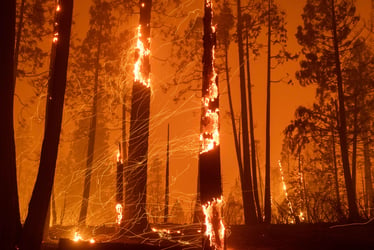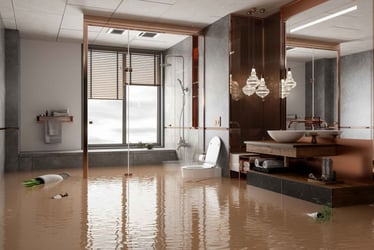Related Posts



You are about to leave Risk Strategies website and view the content of an external website.
You are leaving risk-strategies.com
By accessing this link, you will be leaving Risk Strategies website and entering a website hosted by another party. Please be advised that you will no longer be subject to, or under the protection of, the privacy and security policies of Risk Strategies website. We encourage you to read and evaluate the privacy and security policies of the site you are entering, which may be different than those of Risk Strategies.

Imagine this: You're the proud owner of a stunning high-value home nestled in the picturesque hills of a wildfire-prone region. The panoramic views from your windows are breathtaking. However, despite the beauty, a hidden danger lurks just beyond your doorstep.
One hot dry day, a wildfire breaks out nearby. Within hours, the fire rages out of control, spreading rapidly toward your neighborhood. Despite hearing about the importance of “defensible space,” you never took action.
The fire starts to engulf your neighborhood, and then the landscape around your home. The lack of defensible space allows the flames to creep closer and closer until they almost reach your home. The intense heat and flying embers ignite everything in their path.
Luckily, no one is home. But your home, collections, memories, and investment are all at risk of being reduced to ashes. Proactive wildfire protection measures could have made a difference.
Wildfires in the U.S. have grown larger, more frequent, and more destructive in recent years. According to research from Pew Charitable Trusts, from 2017 to 2021, the average annual acreage burned by wildfire in the U.S. was 68% greater than the yearly average from 1983 to 2016. A congressional report estimates that wildfires cost the U.S. economy between $394 billion to $893 billion each year.
The threat of wildfire is clear and present. In 2023 alone, catastrophic wildfires spread in California and across the Western United States and to traditionally humid regions — including Florida and Hawaii. The increased risk of wildfire is spreading across the country, all the way to the East Coast. In short, nowhere is safe, and everyone must take proactive steps to protect their homes.
Creating defensible space and hardening your home through strategic, proven tactics are crucial to safeguarding homes from destruction. These strategies are especially important for high-net-worth individuals living in wildfire-prone regions. Let’s dig into best practices for creating defensible space, top considerations for hardening your home, and the insurance implications of not doing so.
A defensible space serves as a fuel break (barrier) between your home and the wildfire, reducing the likelihood of ignition from radiant heat, embers, or direct flame contact. Defensible space is specifically designed to reduce the risk of wildfire reaching your home.
Creating defensible space also provides a safer environment for firefighters to defend your home, allowing them to access your property more easily and reducing the risk to their safety. Given the larger homes and lot sizes of high-value properties, especially in wildfire-prone areas, defensible space is essential for protecting these investments.
Creating defensible space can be time-intensive and can be a significant investment to protect against a scenario that may or may not happen. But if a wildfire does come creeping towards your door, the benefits will become immediately clear:
The following guidelines and steps will help you create defensible space and better protect your property. The National Fire Protection Association (NFPA) subdivides defensible space into three zones (Zone 0, Zone 1, and Zone 2), based on proximity to a home or structure. It is important to also know your Local and State Ordinances, as there may be additional or more strict rules and requirements specific to your location.
Zone 0 of defensible space, also called the Immediate Zone, is the first 5 feet around the home. The goal of this zone is to make this a non-combustible area, to protect the home and prevent embers from entering.
Only use plants that are considered safe for wildfire-prone areas.
Zone 1 of defensible space, also called the Intermediate Zone, is located 5 to 30 feet from the home. The goal of this zone is to reduce flammable materials near the home and reduce connectivity between trees, shrubs, and other landscape features.
Remove any “ladder fuels” within 6 feet of the ground. Ladder fuel (or fuel ladder) is a term for live or dead vegetation that allows a fire to climb from the landscape or forest floor into the tree canopy. Common ladder fuels include tall grasses, shrubs, and tree branches, both living and dead.
Zone 2 of defensible space, often referred to as the Extended Zone, is located 30 to 100 feet, or more, from the home. The goal of this zone is to create fuel breaks, reduce heat transfer, and prevent wildfires from moving closer to the home.
Regularly thin trees and brushes to maintain adequate spacing and to minimize the fuel load and the likelihood that the fire will spread.
Regularly remove dead vegetation and debris.
Horizontal Spacing: Trees 30 to 60 feet from the home should have at least 12 feet between canopy tops. Trees 60 to 100 feet from the home should have at least 6 feet between the canopy tops.*
Vertical Clearance: Follow the vertical clearance recommendations outlined for Zone 1.
Creating defensible space is one piece of the property-protection puzzle; hardening your home is another. Wild fires threaten homes and properties with direct flames, radiant heat, and flying embers. Making strategic changes to your home, including materials, installation practices, sealing, and maintenance, can increase its chances of survival if a wildfire strikes.
By following these tips, you can create a more fire-resistant home. Even minor improvements can make a big difference. Proactive defensive measures you can take include:
Although there are many risks management measures you can proactively take as a homeowner, there are also some items that are out of your control based on the location of your property.
Many insurance carriers review Risk Scoring and Protection Classes to underwrite homes and property. Risk Scoring and Protection Classes are based on where your residence is located and how prone it is to future wildfire events. Some of the components that go into Risk Scoring include the following:
Homeowners’ insurance is crucial for protecting homes in all regions, and especially so in wildfire-prone regions and locations susceptible to any type of natural disasters and severe weather. Creating defensible space and hardening your home can help make your property more attractive to underwriters.
Below are some of the actions that insurance companies may take when properties are not adequately fire-safe or have insufficient defensible space. Risk Scoring and Protection Classes also are factored into decisions related to insurability, deductibles, limits, and rates.
Creating defensible space and hardening your high-value home against wildfires is an investment in peace of mind and the legacy you build. Don't wait for disaster to strike. It is important to control what you can. Take proactive steps today to safeguard your valuables, your loved ones, and your property.
Partner with expert advisors and experienced insurance brokers to secure adequate homeowners’ insurance. These professionals understand the unique needs of high-net-worth individuals and can tailor insurance policies to address specific risks, such as wildfire exposure. Their expertise, alongside defensive measures, can ensure your home is protected for generations to come.
The Risk Strategies Private Client Risk Resource offers helpful checklists and resource guides to keep you informed and help you manage and mitigate your risk exposure. Our wildfire guides can help you in case of emergency:
The contents of this article are for general informational purposes only and Risk Strategies Company makes no representation or warranty of any kind, express or implied, regarding the accuracy or completeness of any information contained herein. Any recommendations contained herein are intended to provide insight based on currently available information for consideration and should be vetted against applicable legal and business needs before application to a specific client.


